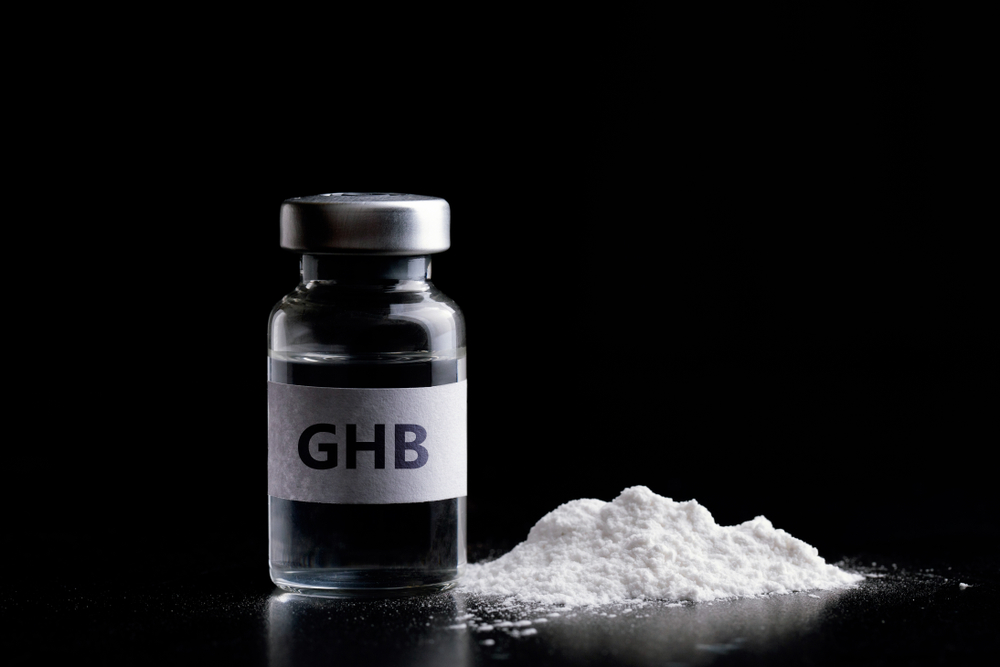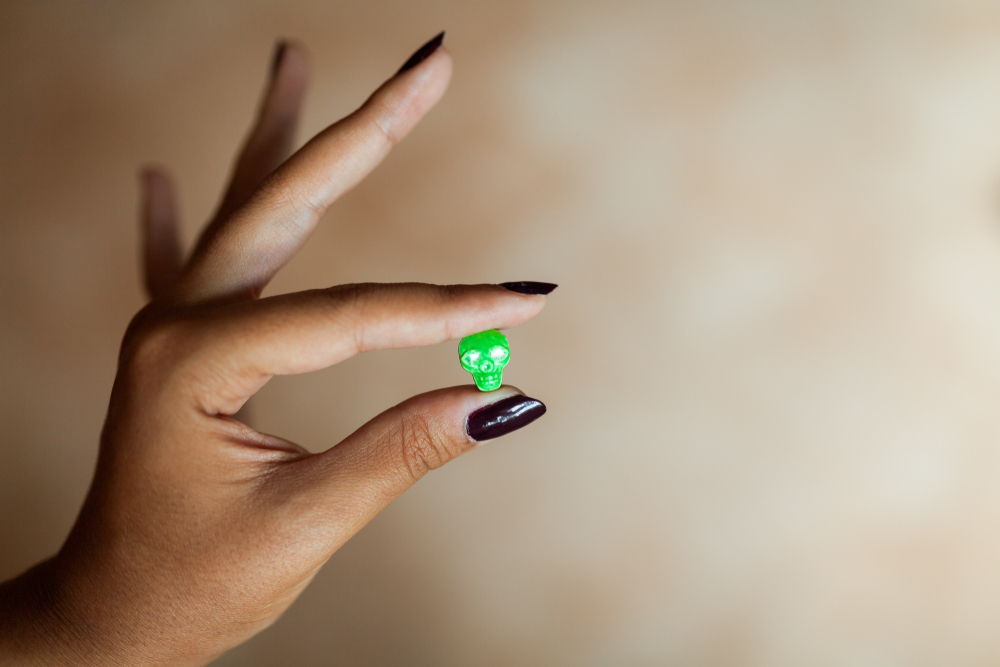Last Updated:
May 16th, 2025
GHB/GBL Addiction | Symptoms, Effects and Causes
What are GHB and GBL?
GHB (gamma-hydroxybutyrate) is a depressant that affects the central nervous system, often used recreationally for its sedative and euphoric effects. GBL (gamma-butyrolactone) is closely related, as the body converts it into GHB after ingestion. While similar, GBL is usually more potent and works faster.
GHB is typically found as a clear, odourless liquid stored in small bottles or capsules, while GBL is often used industrially in products like paint strippers or cleaning agents.
In the UK, GHB is a Class C drug, making possession or supply illegal without approval. GBL is legal in industrial products, but it’s illegal to sell or possess it if there’s intent to use it for human consumption.

What makes GHB and GBL addictive?
GHB is addictive because of how it interacts with the brain. It stimulates the release of dopamine, a chemical linked to feelings of pleasure and reward. Over time, the brain adjusts to GHB’s effects, requiring more of the substance to achieve the same euphoric feeling. This creates a cycle of dependence, with withdrawal symptoms like anxiety, tremors and insomnia making it difficult to stop.
GBL’s addictive nature comes from its conversion into GHB in the body. As a result, GBL has similar effects, but its faster onset can lead to repeated use in a shorter time frame, increasing the risk of addiction. GBL’s role in this rapid cycle of dependency makes it highly addictive and challenging to quit.
Why do people take GHB?
There are several reasons why people take GHB and it often comes down to the effects it has on the body and mind. Its relaxing and euphoric qualities can make it appealing for winding down or escaping stress. In social settings, it’s sometimes used to feel more confident, loosen up or connect with others more easily.
GHB is also linked to the ‘chem-sex’ scene, where people use it to intensify sexual experiences. Its ability to heighten sensations and reduce inhibitions is a big part of why it’s popular in this context, though it comes with serious risks.
Some might try GHB out of curiosity, to help them sleep or to boost performance, often without realising how quickly it can become addictive.
Signs of GHB and GBL addiction
Recognising the signs of GHB and GBL addiction is crucial for seeking help, whether for yourself or a loved one. Since GBL converts into GHB in the body, their effects and signs of addiction are comparable, so the following signs apply to both substances. Identifying these behaviours, physical symptoms and psychological changes can help you take the necessary steps toward recovery.
- Frequent use in social or private settings: Using GHB/GBL to enhance social interactions or relax may signal reliance.
- Neglecting responsibilities: Missing work, school or family commitments due to prioritising use.
- Risk-taking behaviours: Engaging in dangerous activities like driving while under the influence.
- Lying or secrecy: Hiding usage or making excuses to cover up the frequency of consumption.
- Increased financial strain: Spending significant money to obtain the substances, sometimes at the expense of essential needs.
- Changes in sleep patterns: Extreme drowsiness or insomnia due to GHB/GBL’s sedative effects.
- Withdrawal symptoms: Tremors, sweating and muscle pain when not using.
- Weight loss or gain: Changes in appetite caused by the substance’s impact on the body.
- Slurred speech or impaired coordination: Common when under the influence or in withdrawal.
- Unexplained injuries: Falling or accidents due to reduced coordination and awareness.
- Mood swings: Rapid changes in mood, from euphoria to irritability or aggression.
- Increased anxiety or paranoia: Long-term use can heighten feelings of fear and unease.
- Depression: GHB/GBL disrupts dopamine levels, often leading to emotional lows.
- Obsessive thoughts about use: Constantly planning or thinking about the next dose.
- Memory problems: Difficulty recalling events or conversations, especially when under the influence.
Do I have a GHB and GBL addiction?
Even with the signs of addiction in front of you, admitting there might be a problem can be incredibly difficult. What may have started as experimentation or even a way to enhance your sex life might now feel like something you can’t control. If you’re questioning whether GHB or GBL has become an issue in your life, checking in with yourself is a good place to start.
Below are six questions that, if answered with ‘yes,’ could indicate a GHB or GBL addiction:
- Do you feel like you need GHB or GBL to feel confident or relaxed in social settings?
- Have you noticed yourself using GHB or GBL more frequently or in higher doses than you used to?
- Do you experience withdrawal symptoms, like sweating, tremors or anxiety, when you don’t use GHB or GBL?
- Have you prioritised using these substances over responsibilities like work, school or family commitments?
- Do you find yourself hiding your use from others or lying about how often you use?
- Have you tried to stop using GHB or GBL but found it difficult or impossible to do so?

If you answered ‘yes’ to any of these questions, it might be time to consider reaching out for support. Recognising the problem is a courageous first step toward recovery.
How Is a GHB and GBL addiction treated?
Overcoming a GHB or GBL addiction requires a structured and compassionate approach that addresses both the physical and psychological aspects of dependency.
The first stage is detox, where the body is safely supported through withdrawal. This process is essential, as GHB and GBL withdrawal can be particularly challenging, often leading to symptoms like anxiety, insomnia and even more severe reactions. Professional care ensures this stage is as safe and comfortable as possible.
After detox, therapy becomes the focus. A combination of one-to-one counselling, group therapy and holistic treatments helps individuals understand the root causes of their addiction and develop healthier coping mechanisms. Specialised therapies may also address related issues, such as mental health struggles or trauma.
Finally, aftercare provides ongoing support to help individuals maintain sobriety and rebuild their lives. This stage often includes access to counselling, peer support groups and relapse prevention strategies.
With the right support, recovery from GHB or GBL addiction is not only possible but also life-changing. Seeking help is the first and most important step.
What’s next?
If you or someone you care about is struggling with GHB addiction or GBL addiction, don’t wait to seek help. Professional support can make all the difference in overcoming GHB/GBL dependency and starting a healthier, brighter future. Reach out to a rehab centre today. Your journey to recovery begins with one step.
Our compassionate team are ready and available to take your call, and guide you towards lasting the lasting addiction recovery you deserve.
Frequently Asked Questions
(Click here to see works cited)
- Madah-Amiri D, Myrmel L, Brattebø G. Intoxication with GHB/GBL: characteristics and trends from ambulance-attended overdoses. Scand J Trauma Resusc Emerg Med. 2017 Sep 22;25(1):98. doi: 10.1186/s13049-017-0441-6. PMID: 28938889; PMCID: PMC5610436.
- “Drugs Associated with Chemsex.” NHS Choices, NHS, www.sexualhealthsheffield.nhs.uk/info-and-advice/chemsex/drugs-associated-with-chemsex/. Accessed 21 Jan. 2025.
- Jan van Amsterdam a b, et al. “Risk Assessment of GBL as a Substitute for the Illicit Drug GHB in the Netherlands. A Comparison of the Risks of GBL versus GHB.” Regulatory Toxicology and Pharmacology, Academic Press, 6 Sept. 2014, www.sciencedirect.com/science/article/abs/pii/S0273230014002037.

